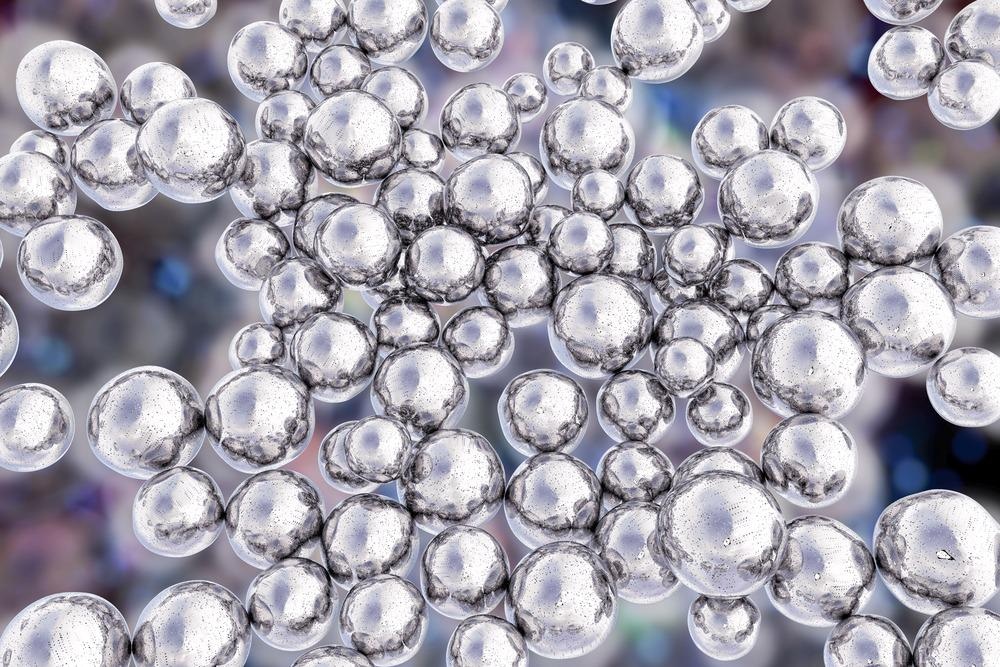In a paper printed in the journal Applied Materials & Interfaces, surface plasmon resonance microscopy was used to investigate the dissolving mechanism of nanomaterials at the single-particle level. The double influence of organic substances on the solubility of silver nanoparticles was also investigated.

Study: Single-Particle Electrochemical Imaging Provides Insights into Silver Nanoparticle Dissolution at the Solution–Solid Interface. Image Credit: Kateryna Kon/Shutterstock.com
Applications of Silver Nanoparticles
Silver (Ag) nanoparticles have many uses spanning from spectroscopy and processing to medicinal therapy due to their superb visual, enzymatic, and wide-ranging antibacterial capabilities. However, increased manufacturing to supply this demand has resulted in an inevitable rise in the number of silver nanoparticles discharged into the aquatic system, which may have negative environmental consequences.
The oxidative decomposition of discharged silver nanoparticles is a fundamental environmental change that determines the shape and amount of silver to which sea creatures are susceptible. This transition may affect nanoparticle characteristics and is regarded as a critical factor in the acute contamination and sustainability of silver nanoparticles.
When you look at the process of oxidative dissolution, for example, you can determine the effects nanomaterials will have on the environment.
Research has previously been conducted to investigate the solubility of silver nanoparticles under different situations using various analytical methods. Nanoparticles disintegrate and aggregate simultaneously; thus, these two methods interact to influence the metamorphosis of silver nanoparticles in aqueous settings.
Effects of Aggregation on Dissolution Process
In past research, atomic force microscopy and nanoparticle lithography were coupled and utilized to monitor silver nanoparticle decomposition under limited environments. This arrangement offers the benefit of assessing silver nanoparticle dispersion independently of aggregation, but it also has significant drawbacks, including expensive apparatus, high running expenses, and advanced preparative processes.
More significantly, the organized deposition of silver nanoparticles on the surface differed markedly from real-world conditions. Whenever silver nanoparticles are subjected to aqueous conditions, their protective film may be dislodged and coated with organic debris. Such capping compounds can stop or speed up aggregation and change the rate at which nanoparticles break down.
Focus of the Current Study
In the present research, surface plasmon resonance microscopy was used to investigate the dissolving of nanomaterials at the single-particle level. Surface plasmon resonance microscopy is an advanced optical technology developed by some organizations that have been used to identify nanoparticles and viruses.
Electron vibrations create surface plasmons, which travel over the surface and form an emission spectrum. This signal deteriorates rapidly towards the contact, making the plate very sensitive to small changes in the index of refraction.
The oversensitivity to changes in the local index of refraction on a surface allows surface plasmon resonance microscopy to determine chemical stability and shape mapping. This can help monitor the accumulation and disintegration of silver nanoparticles.
This method was used to calculate the solubility classes of silver nanoparticles, characterize the disintegration behaviors of individual nanoparticles, and evaluate the link between aggregation sizes and solubility at the individual particle level.
Highlights of the Study
Studying nanoparticle dissolving mechanisms is critical for predicting their destiny in the aquatic system. Nonetheless, nanoparticle solubility and aggregation are linked and may influence nanotechnology evolution.
Since ensemble-based studies fail to isolate the connections between aggregation and dispersion, data on nanoparticle variation cannot be obtained. It is debatable and uncertain how the aggregation condition influences the solubility of nanoparticles. A sophisticated visual technique was demonstrated to measure individual nanoparticles' aggregation and solubility to reveal this mysterious phenomenon.
The disintegration kinetics of individual and aggregated nanoparticles was assessed thanks to single-particle imaging and enumeration capabilities. More interestingly, this method offered a new understanding of the connection between aggregation and solubilization at the single-particle level that other methodologies could not.
It was shown that this approach could be utilized to address certain possible ecological issues with nanoparticle change at the single-particle level. As a result, it is expected that this strategy will increase the knowledge of nanoparticle destiny in aquatic settings, and the scientific method used in this study may serve as a paradigm for future investigations into the metamorphosis of Zinc, Copper, and certain other nanoparticles.
Reference
Jiang, D., Chen, H.-B., Zhou, X.-L., & Liu, X.-W. (2022). Single-Particle Electrochemical Imaging Provides Insights into Silver Nanoparticle Dissolution at the Solution−Solid Interface. Applied Materials & Interfaces. Available at: https://doi.org/10.1021/acsami.2c05148
Disclaimer: The views expressed here are those of the author expressed in their private capacity and do not necessarily represent the views of AZoM.com Limited T/A AZoNetwork the owner and operator of this website. This disclaimer forms part of the Terms and conditions of use of this website.